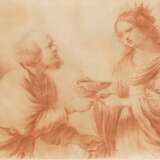ID 53112
Lot 126 | Giovanni Francesco Barbieri called il Guercino
Estimate value
€ 20 000 – 30 000
Queen Artemisia receiving the ashes of her husband King Mausolus, c. 1642, red chalk on laid paper, 24 x 36,5 cm, mounted, framed, ( Sch )
Provenance:
Private collection, Italy.
Literature:
See Nicholas Turner, The Paintings of Guercino. A Revised and Expanded Catalogue Raisonné, Rome 2017, Cat. 282, p. 572; Denis Mahon, Nicholas Turner, The Drawings of Guercino in the Collection of Her Majesty the Queen at Windsor Castle, Cambridge 1989, No 728; Miriam Di Penta, "Guercino's Endymion, Hercules and Artemisia for Alessandro Argoli", in: Journal of the Warburg and Courtauld Institutes, LXVII (2004), pp. 233-54, Fig. 10,11; C. C. Malvasia, Felsina pittrice: Vite de' pittori bolognesi, Bd. II, p. 373.
The attribution to Giovanni Francesco Barbieri called il Guercino was confirmed by Dr. Nicholas Turner after inspection of the drawing in the original. The present sheet is a preliminary study for the painting „Queen Artemisia receiving Mausolus’ ashes“. This painting was mentioned by Malvasia in 1642 (Malvasia 1678, II, p. 373) and is preserved in the Schoeppler Collection, London today.
The work may have been commissioned by Alessandro Argoli. It is considered a companion piece of a painting representing „Hercules“ and may have been intended as a gift for Taddeo Barberini. According to the legend Artemisia drank the ashes of her husband who had died two years before. Thus she applies to the role model for the virtues of a widow. The subject of the painting may point to the conjugal virtues of Anna Colonna Barberini (1601-58) whereas the Hercules painting may be an allusion to the courage and the heroic military deeds of her husband Taddeo.
An earlier design, which is preserved in the form of two transfers being kept in the collection of Windsor Castle (Turner 2017, Cat. 282; Mahon und Turner 1989, No 728; RCIN 903183) as well as in a print by Stefano Mulinari of 1797 (see Di Penta 2004, Fig. 10, 11), passed down an early composition of the subject.
The compositon of the earlier design is inscribed in an upright format; like in the present drawing Artemisia is wearing a crown; she is embracing the urn of her husband with the left arm and with her right arm is holding the goblet and drinking the ashes dissolved in it. In the present drawing Artemisia is receiving a similar goblet.
According to Dr. Turner the present design is an advanced solution of the earlier drawing. Larger costs may have been the reason that the patron refused to have a figure added to the composition and that he had the drawing respectively the painting executed in a format larger than the present one. In a later drawing which is also preserved in Windsor Castle the composition is limited to the presentation of Artemisia as a half-length figure in an upright format. She is holding the cup with the ashes of her husband with two hands; the crown rests next to her on a table near the right margin of the picture.
We are grateful to Dr. Nicholas Turner for the scientific support in regard of cataloguing the present drawing.
The buyer‘s premium shall be as follows:
a) for items subject to margin tax (not specially marked in the catalogue/in the description) or for sales where the Dorotheum acts as an agent (marked with a “V” [“Vermittlung” = agent sale] in the catalogue/in the description):
■ up to an amount of EUR 100,000: 25% of the hammer price
■ for the amount exceeding EUR 100,000: 22%
■ for the amount exceeding EUR 600,000: 15%
In these cases the buyer‘s premium includes the statutory VAT
b) for fully taxable items (marked in the catalogue/in the description with the symbol „+“ for 20% VAT, with „–“ for 13% VAT or with „#“ for 10% VAT):
■ up to a hammer price of EUR 100,000: 20,84% of the hammer price
■ for the amount exceeding EUR 100,000: 18,34%
■ for the amount exceeding EUR 600,000: 12,5%
In the case under (b), the statutory VAT is calculated based on the total price (hammer price plus buyer‘s premium and a possible resale right royalty) and is added to the total price.
| Address of auction |
Palais Dorotheum Dorotheergasse 17 1010 Wien Australia | ||||||||||||||
|---|---|---|---|---|---|---|---|---|---|---|---|---|---|---|---|
| Preview |
| ||||||||||||||
| Phone | +43 01 515600 | ||||||||||||||
| Fax | +43-1-515 60-443 | ||||||||||||||
| Conditions of purchase | Conditions of purchase | ||||||||||||||
| Payment methods |
Wire Transfer | ||||||||||||||
| Business hours | Business hours
|




